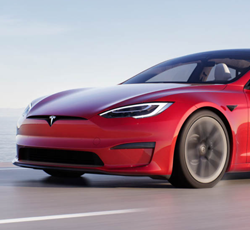
Tesla's Next-Gen Roadster: A (speculative) technical look at the car ...
- by Electrek
- Nov 20, 2017
- 0 Comments
- 0 Likes Flag 0 Of 5

0 Comments
After seeing the new Roadster in the flesh at Thursday’s Tesla Semi unveiling, I’ve had a lot to think about. Fred and Seth already both covered this car, but it’s so groundbreaking that I felt I needed to chime in.
And as a current Roadster 1.5 owner, which had been my dream car ever since seeing the first introductory website put up by Tesla way back in 2006, I’m writing this article as a sort of catharsis, a reliving of that night that I first saw the car I sorely wished could be mine but thought at the time I’d never have the opportunity to own.
This article will be a bit of a deeper dive into some of the specs, how they may have been attained, with whatever speculation and Roadster-owner-experience I can throw in. I’ll try to explain the concepts I go over, not because I feel our readers won’t understand them, but just in the interest of completeness and in reaching as wide an audience as possible.
Advertisement - scroll for more content
Quick disclaimer, I’m not actually an engineer. The explanations of the concepts within should be accurate as an introduction to these concepts, though since this is the internet, I’m sure I’ll hear otherwise in the comments if anything is wrong. So if you’re ready to engage in a little bit of bench racing, some explanations of many aspects of vehicle dynamics and how they relate to the new Roadster, let’s dig right in to the specs of the car that Tesla CEO Elon Musk said will “give a hard-core smack down to gasoline powered cars.”
Power
First thing’s first, let’s talk about the go-fast stuff. With Tesla’s stated specs, and with that huge battery, this car must have a lot of power. The 200kWh battery isn’t just there for range, it’s for power. Power (kW) is how much “oomph” you can deliver instantaneously, as opposed to energy (kWh) which is the amount of storage you have and thus how far you can go.
The batteries Tesla uses tend to have relatively low power density and higher energy density, so to get a lot of power, you need a lot of batteries (as opposed to, say, supercapacitors, which have great power density but bad energy density). This is why Teslas with larger batteries tend to have more power, and consequently quicker acceleration.
The original Roadster had an at-the-time massive 53kWh battery, which gave it ample low-end torque and good power for such a small car. However, getting up into the higher speeds, there wasn’t quite as much “oomph.” While the car will throw your head back violently up to about 50mph, there’s a little bit to be desired past that speed (not that it’s deficient, it’s just not as violent).
Tesla designed the original Roadster with a two-speed transmission in the hope of attaining similar 60-120 acceleration as 0-60 acceleration, but it didn’t work out and Tesla updated all cars to the “1.5” powertrain, which was simpler and improved performance in many ways.
Since then, Tesla has gone with single gears – though the dual-motor versions of the Model S have different ratios on the front and rear axle, which helps efficiency when cruising at higher speeds. It’s likely that Tesla will do the same with the Roadster, and have the front motor geared more for top speed and the rear motors geared for acceleration.
In the new Roadster, there is no sense of a loss of “oomph” even as high as 80mph (which is about as fast as the test rides went at the unveiling event).
The only number Tesla gave us related to power during the unveiling was 10,000Nm, which is equivalent to 7,375ft•lbs of torque (*see edit below). 10,000Nm of torque is basically unheard of in anything with wheels.
(*Edit: a reader points out in the comments that Tesla was quoting “torque at the wheels” rather than the torque coming out of the engine/motor. The difference is that the former number is torque after being mutiplied by the gearing in the car’s transmission – which should be a ratio of around 9:1 as it is on most of Tesla’s cars. On Tesla’s website, it specifies “wheel torque,” but during the event just the word “torque” was used. Normally cars quote torque coming out of the engine, so it seems like Tesla was overhyping this spec and I got a little overzealous in reporting it uncritically. Regardless, the Model S has 930Nm of torque so the Roadster will probably still have around ~1,100Nm of torque, and this is still an obnoxiously high number, on par with the most torquey cars in existence)
With those ridiculous torque numbers, given that we’ve seen a Model X out-drag an Alfa Romeo while towing an Alfa Romeo, it almost makes you feel like a Roadster could accomplish the same feat. Unfortunately, it is quite unlikely that the Roadster will have a tow hitch – even though Tesla CTO JB Straubel put one on his original Roadster (disclaimer: DO NOT DO THIS – a sportscar’s suspension and chassis are not built for it and it will certainly be contra-indicated by the owner’s manual).
But torque and power are not the same – torque gets you off the line, power gets you up to high speeds. Also, peak torque doesn’t mean much (peak horsepower perhaps means even less). Horsepower is calculated by (torque * rpm) / 5252. Most car specs are quoted in “peak” numbers, but due to the way “torque curves” work on ICE engines, those peak horsepower numbers may only be available within a specific rpm range – this is why ICE cars have so many gears, to try to stay in the best rpm range for the motor.
A “torque curve” shows how much torque and power an engine develops at various points in the RPM range – so a “peaky” torque curve may have a high peak number, but what you really want is an engine which can provide good torque and hp across a broad portion of the rpm range (Tesla talked about that briefly near the end of this old blog post). For an example of how this looks, in this graph torque is the solid line and horsepower is the dotted line – the x-axis is labeled in speed because in a single-gear transmission, speed and RPM are directly related:
The Model S motor can spin up to ~18,000rpm and the original Roadster up to ~14,000, so we can expect similar rpms from the new Roadster. Electric motors provide maximum torque at 0rpm, which is why they have such dominant performance in initial acceleration. Then they have a flat torque curve until some point at which torque drops off depending on how much power can be delivered by the battery. Since horsepower is torque times rpm, as the torque drops off and the rpms go up, horsepower remains roughly flat even after torque begins to drop, then horsepower drops off slowly at even higher speeds.
Since the new Roadster’s quoted torque number is so much higher than anything reasonable, it’s likely that the Roadster will only be able to sustain 10,000Nm for just the initial launch, maybe up to ~1,000rpm – and it probably will have a tough time delivering all of those 10,000Nm to the ground, due to the limitations of traction (see Tires section below for more on that).
As for power, given that the battery is about twice the size of the Model S, which Tesla claims can produce 778hp (more on that here), I’m estimating that power will be in the megawatt range, so around 1,300 horsepower. Give or take.
There are a few other megawatt cars out there, but they are rare and each costs over a million dollars. The Rimac Concept_S makes a megawatt of power, and does so with an 82kWh pack, as does the NIO EP9. Then there are custom built Pike’s Peak racers, the Koeniggsegg Regera and the aforementioned Bugatti Chiron in this category. Notably, the “big three” hybrid hypercars right now, the Porsche 918, MclarenP1 and LaFerrari all do not make a megawatt of power. Even Formula One cars don’t make that much power.
And this power seems like it should be enough to reach Tesla’s stated top speed of 250mph+, accounting for drag at high speeds.
Aerodynamics
If Tesla wants to reach over 250mph (400kmph) with this car, it’s going to take a lot of horsepower to overcome air drag at that speed. But according to the drag equation, this should be readily attainable. For reference, I used a drag coefficient (Cd) of .35 (similar to the .36 of the Bugatti Chiron mentioned in the presentation), and I used the new NSX’s frontal area as the two cars look kind of similar (19 sqft or 1.78 square meters).
So at 250mph, the Roadster would need roughly 750hp (560kW) to overcome air drag given these assumptions. But as stated before, it seems like the Roadster could have somewhere in the ballpark of a megawatt of power, and the car will likely have a lower Cd than my estimate, though perhaps not by too much, since low coefficients aren’t necessarily the only goal of a sportscar.
Back on the Bugatti Chiron for a moment, in the presentation on the Tesla Semi, Musk mentioned that the Semi has the same Cd as a Bugatti Chiron. This was somewhat of a meaningless comparison – supercars are meant to be a little bit draggy, because if they slipped through the air too well, then they’d lift right up off the road. This is why you see wings (aka spoilers) and active aerodynamic features on cars which are meant to travel at such high speeds. The Roadster does include one of these, as you can see in the press shot below.
Wings work by disturbing the air, pushing the air upwards to produce an opposite and equal force downwards on the car, called downforce. This aids cars in cornering and also helps them stick to the road at very high speeds, because there is a natural lift created by a vehicle going at very high speeds, somewhat like an airplane wing (see NASA’s “racing physics” page for a little more on this). Formula One is the epitome of fast racing cars, and they have a Cd of roughly .7 – because they need as much downforce as possible to take turns at the incredibly high speeds they do.
But since wings push air around, they do create drag, so it’s best to focus on the most “aerodynamically efficient” devices. Aerodynamic efficiency refers to the ability to create downforce with as little drag as possible. The underbody of a car is often a good location to focus on for aerodynamic efficiency. Tesla has a benefit here, because by placing the battery at the bottom of the car, they can have a naturally very flat underbody. Also, the rear end of the car has quite a large “diffuser,” which is a device meant to keep the air flowing steadily under the car, as undisturbed as possible. The diffuser is the big carbon fiber bit in the photo below:
By allowing air to flow quickly and undisturbed under the car, not only do you create less drag (turbulent air is more draggy), you also create some downforce. This is very important to reach high top speeds, because it helps “suck” the car down to the road. It also aids in cornering, as traction increases when there is more downward force on the tires.
Tires
The tires on the prototype are Michelin Pilot Sport Cup 2 325/30ZR21 (104Y) rear and 265/35ZR20 front. These have a “Y” speed rating, which means they have a maximum speed of “over 186mph (300kmph).” They are the same tires used on the Porsche 918 Spyder (which has a 211mph/340kmph top speed).
These are listed as “streetable track & competition” tires, which means they are legal to drive on a public road, but are focused on track performance and are not meant to be driven in wet conditions. This may be the reason some Roadster test rides experienced wheelspin during low-end acceleration, as there was a light sprinkle of rain during the event, and on a smooth and dusty runway this can make for a slippy experience. You can hear the wheelspin 5 seconds into Seth’s 360º Roadster Test Ride video.
The numbers I talked about above refer to the size of the tires. The first number is the width of the tire in millimeters, the last number is the size of the rim in inches, and the middle number is the “aspect ratio” of the actual tire itself (bigger numbers = thicker tires, smaller = skinny “rubber band” tires). The width of the tires is of particular note, as 325/265 are very wide. The original Roadster had tires of 225/175, so the new tires are roughly ~50% wider. Combine this with the larger diameter of the rim-tire combo, and the “contact patch,” the amount of rubber which hits the road, is maybe almost double what the original Roadster’s contact patch is.
The reason for this is partially because the new Roadster is heavier than the original Roadster (heavier vehicles typically need larger tires and have larger contact patches), but primarily because the only way to get a sub-2-second 0-60 time is to have a whole lot of rubber in contact with the road. Since the only way power gets transferred into forward motion is by the friction of tires against the road, the more rubber you can have in contact with the road, and the stickier that rubber is, the more forward motion you get.
Not only that, but the original Roadster is only rear-wheel drive, rather than all-wheel drive. This is why all-wheel drive cars tend to accelerate better than front- or rear-wheel drive cars, because they’re using all four tires to push the car forward, instead of just two (though the rear wheels do more of the work, since the car’s weight leans backwards upon acceleration).
All of this can be seen in action in the case of the P100D Model S, which has roughly the same 0-60 time as it does 60-0 time. This means that for the entirety of the 0-60 acceleration period, the car is moving forward as quickly as the tires allow – the only way to make it go quicker would be to give it bigger tires or less weight, more power is superfluous when you are “traction-limited.”
The downside to larger tires and more grip is that the car is less efficient than it would be with smaller tires, but I would still expect an MPGe rating somewhere in the neighborhood of 100 even despite that, and honestly, that’s not really the main point of this car now is it? The tires are also more expensive ($600 per tire on TireRack), but, again, it’s a hypercar. That comes with the territory.
Large tires also mean more grip for cornering, which will be necessary because the new Roadster seems like it will be significantly heavier than the original one.
Weight
The original Roadster focused a lot on staying light weight. The chassis was designed and manufactured in collaboration with Lotus Engineering. Lotus was started by legendary car designer Colin Chapman, whose philosophy is often summarized as “simplify, then add lightness.” The idea is that to make a car perform better, you don’t “add” more weight, more power, more tires, etc., you try to remove every bit of superfluous weight you can, because the lighter your car is, the better it will be in all aspects of vehicle performance.
As a result, the whole car came in at 2,723lbs (1,235kg). This is very light – it’s heavier than similar light, two-seater convertible roadsters like the Lotus Elise and Mazda MX-5 due to the battery, but lighter than almost any production car available today, even hypercars like the LaFerrari (2766lbs/1255kg). Though it could really benefit from the weight savings that a newer, more energy dense battery would provide – like the Roadster 3.0 battery update, only with the original 53kWh usable capacity and lighter, newer cells. The re-engineering required and low production number of the original Roadster make this an unlikely thing to happen, though.
The weight of the car is probably going to be slightly rear-biased, as the tires in the rear are larger and the rear has two motors, with just one in the front. The original Roadster also had heavily rear-biased weight because the battery was placed behind the seats, which helped a lot with traction to get the at-the-time-incredible sub-4 second 0-60 time.
It’s unlikely that the new Roadster will manage anything close to the original Roadster’s weight. The aforementioned 200kWh battery will be heavy – very heavy. The current 100kWh pack in a Model S weighs more than 1,000lbs (453kg). Even with the next couple years of battery advancement, it seems likely to me that the pack alone will be close to 2,000lbs (907kg). Then add three electric motors, seats, a (probably aluminum) chassis, and a body which felt like it was made of either carbon fiber or fiberglass, and this car seems like it will be, at minimum, in the mid-high 3,000s or possibly above 4,000lbs (1814kg). The body is likely carbon fiber given the price – there were many carbon fiber accents in the prototype’s interior, see dash in picture below:
That would be a lot heavier than the original Roadster, but it’s not out of line compared to other hypercars available today. Most of them are in the ~3,500lb range, and the Bugatti Chiron is 4,400lbs (1,996kg). Weight isn’t a big disadvantage in terms of straight-line top speed, as it’s easier to keep a lot of weight moving than to get it moving in the first place. But weight is a disadvantage when it comes to cornering ability and vehicle handling.
Handling
This is my one area of concern with the Roadster’s performance. Weight is absolutely critical in terms of cornering ability, there is nothing more important. The more your car weighs, the harder it is to get to change directions, period. Cornering requires applying a force to change the car’s velocity vector (the direction and speed it’s moving), and the heavier that car is, the more force will be required to change that vector. So, the more “lightness” you can “add” to your car, the better it will turn.
So from this perspective, the Roadster’s gigantic battery seems excessive. Such a huge battery is pretty important to reach the power levels which Tesla wanted to hit with this car, but this will cause a deficit in vehicle handling as compared to a smaller car.
There are some ways to mitigate this though. As mentioned earlier, the huge tires help a lot with any kind of grip. Having roughly twice the contact patch of the original Roadster means twice as much rubber on the road, which means twice as much friction, which means the tires can “push” twice as hard around the corner before losing grip.
Another mitigating factor is the car’s center of gravity. A car with a high center of gravity will introduce more “roll” when going around a corner, which means the weight of the car will lean onto the tires on the outside of the turn. If there’s more weight on the outside tires, that means there’s less weight on the inside tires, and the inside tires are no longer going to be as effective in providing grip to help turn the car around the corner.
A low center of gravity reduces roll, which means the inside tires stay stuck to the ground better, and in turn provide more grip. This is how the Model S tends to out-handle other vehicles of the same weight, because it has an exceptionally low center of gravity – about 17.5 inches. This is on par with the Ford GT and lower than the Ferrari 458 and Subaru BRZ, which are all famously low-slung cars, whereas the Model S is a 5(+2) seat sedan.
All of the same principles apply to braking – it’s harder to slow down a heavier vehicle, but with a large contact patch (more grip) and a low center of gravity (less “dive”, so the rear wheels stay in better contact with the road), you can make a vehicle brake more effectively.
Finally, the Roadster’s two rear motors can probably also be used for a concept called “torque vectoring,” where the electric motors are used to apply different amounts of torque to the inner and outer tire – assuming the motors have each been designed to control an individual rear wheel. When going around a corner, if the inner wheel provides some negative torque relative to the speed of the car, it can help to turn the car in the desired direction.
That said, even with all this mitigation to help handling, I would still like to see “lightness” play a big role in the design of the car. Because the better a car’s handling, the better its track performance.
Track performance?
Tesla’s cars have, as of yet, not had fantastic track performance. The Roadster can complete a couple hot laps on a typical ~2-3 mile (3-5km) long track before the battery gets too hot to continue, and the Model S couldn’t quite complete a full lap of the Nurburgring (~13 miles/20km) before it had to cut power. But neither of those cars were really designed for track performance – the Roadster was intended as a sportscar but was a “first-try” and more of a proof-of-concept than anything, intended to show that EVs are cool and quick.
And Tesla doesn’t have a racing heritage and hasn’t put effort into joining any racing series. These decisions currently make business sense for them, because racing is typically motivated in large part by marketing. Automakers of performance vehicles brag about racing wins to sell cars – “win on Sunday, sell on Monday” is a common saying in the auto industry. Since Tesla has been supply-limited for some time and will continue to be, and doesn’t even have TV advertisements, sinking a lot of their marketing budget into forming a racing team may not be the wisest business decision.
That said, we’re in a different time now than we were when the original Roadster came out. When the Roadster came out, people thought EVs were slow and unappealing, and Tesla changed that. Tesla has continually gone on to prove most of the excuses people make about EVs are misguided, and they’ve shown that their cars are faster than everything else on the road at every practical speed. Even the drag strip is now the domain of EVs. The only domain left is the track.
There have been various EV efforts to show off that EVs can do well on tracks – Panoz is working on a battery-swapping Le Mans EV for next year, Faraday Future and Lightning Motorcycles have both conquered Pike’s Peak (and last year a privateer modified Model S), and the NIO EP9 recently beat every production car ever around the Nurburgring. But none of those efforts are as high-profile as Tesla, and they’re being done with cars that are not readily available.
So Musk’s tweet on Saturday gets the imagination going:
Should clarify that this is the base model performance. There will be a special option package that takes it to the next level.
Please first to comment
Related Post
Stay Connected
Tweets by elonmuskTo get the latest tweets please make sure you are logged in on X on this browser.






 Energy
Energy


















